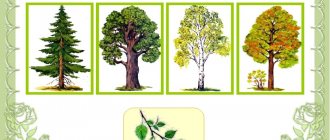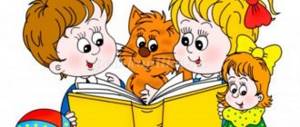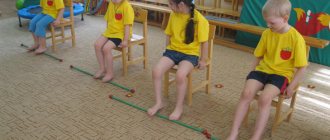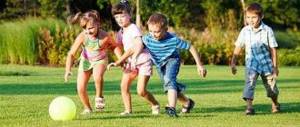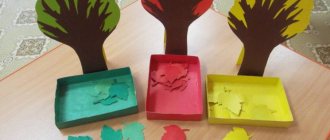Card index of games-experiments in valeology
Card index of experimental games for children of senior preschool age
Grape submarine
Take a glass of fresh sparkling water or lemonade and drop a grape into it. It is slightly heavier than water and will sink to the bottom. But gas bubbles, like small balloons, will immediately begin to land on it. Soon there will be so many of them that the grape will float up.
But on the surface the bubbles will burst and the gas will fly away. The heavy grape will sink to the bottom again. Here it will again become covered with gas bubbles and float up again. This will continue several times until the water runs out. This principle is how a real boat floats up and rises. And fish have a swim bladder. When she needs to submerge, the muscles contract, squeezing the bubble. Its volume decreases, the fish goes down. But you need to get up - the muscles relax, the bubble dissolves. It increases and the fish floats up.
Egg submarine
Take 3 cans: two half-liter and one liter. Fill one jar with clean water and place a raw egg in it. It will drown. Pour a strong solution of table salt into the second jar (2 tablespoons per 0.5 liters of water). Place the second egg there and it will float. This is explained by the fact that salt water is heavier, which is why it is easier to swim in the sea than in a river.
Now place an egg at the bottom of a liter jar. By gradually adding water from both small jars in turn, you can get a solution in which the egg will neither float nor sink. It will remain suspended in the middle of the solution. When the experiment is completed, you can show the trick. By adding salt water, you will ensure that the egg floats. Adding fresh water will cause the egg to sink. Externally, salt and fresh water are no different from each other, and it will look amazing.
How to get a coin out of water without getting your hands wet?
How to get away with it?
Place a coin in the bottom of a plate and fill it with water. How to take it out without getting your hands wet? The plate must not be tilted. Fold a small piece of newspaper into a ball, set it on fire, throw it into a half-liter jar and immediately place it with the hole down in the water next to the coin. The fire will go out. The heated air will come out of the can, and due to the difference in atmospheric pressure inside the can, water will be drawn into the can. Now you can take the coin without getting your hands wet.
Lotus flowers
Cut out flowers with long petals from colored paper. Using a pencil, curl the petals towards the center. Now lower the multi-colored lotuses into the water poured into the basin. Literally before your eyes, flower petals will begin to bloom. This happens because the paper gets wet, gradually becomes heavier and the petals open.
Natural magnifying glass
If you need to see a small creature, such as a spider, mosquito or fly, it is very easy to do.
Place the insect in a three-liter jar. Cover the top of the neck with cling film, but do not pull it, but, on the contrary, push it through so that a small container is formed. Now tie the film with a rope or elastic band, and pour water into the recess. You will get a wonderful magnifying glass through which you can perfectly see the smallest details. The same effect can be achieved if you look at an object through a jar of water, securing it to the back wall of the jar with transparent tape.
Water candlestick
Take a short stearin candle and a glass of water. Weight the lower end of the candle with a heated nail (if the nail is cold, the candle will crumble) so that only the wick and the very edge of the candle remain above the surface.
The glass of water in which this candle floats will act as a candlestick. Light the wick and the candle will burn for quite a long time. It seems that it is about to burn down to the water and go out. But this won't happen. The candle will burn out almost to the very end. And besides, a candle in such a candlestick will never cause a fire. The wick will be extinguished with water.
How to get water for drinking?
Dig a hole in the ground about 25 cm deep and 50 cm in diameter. Place an empty plastic container or wide bowl in the center of the hole, and place fresh green grass and leaves around it. Cover the hole with clean plastic wrap and fill the edges with soil to prevent air from escaping from the hole. Place a pebble in the center of the film and lightly press the film over the empty container. The water collecting device is ready.
Leave your design until the evening. Now carefully shake off the soil from the film so that it does not fall into the container (bowl), and look: there is clean water in the bowl. Where did she come from? Explain to your child that under the influence of the sun's heat, the grass and leaves began to decompose, releasing heat. Warm air always rises. It settles in the form of evaporation on the cold film and condenses on it in the form of water droplets. This water flowed into your container; remember, you slightly pressed the film and put the stone there. Now all you have to do is come up with an interesting story about travelers who went to distant countries and forgot to take water with them, and begin an exciting journey.
Wonderful matches
You will need 5 matches. Break them in the middle, bend them at a right angle and place them on a saucer. Place a few drops of water on the folds of the matches. Watch. Gradually the matches will begin to straighten out and form a star. The reason for this phenomenon, called capillarity, is that wood fibers absorb moisture. It creeps further and further through the capillaries. The tree swells, and its surviving fibers “get fat”, and they can no longer bend much and begin to straighten out.
The head of the wash basins. Making a washbasin is easy
Babies have one peculiarity: they always get dirty when there is even the slightest opportunity. And taking a child home to wash all day is quite troublesome, and besides, children don’t always want to leave the street. Solving this issue is very simple. Make a simple washbasin with your child.
To do this, you need to take a plastic bottle and make a hole on its side surface about 5 cm from the bottom with an awl or nail. The work is finished, the washbasin is ready. Plug the hole with your finger, fill it to the top with water and close the lid. By unscrewing it slightly, you will get a trickle of water; by screwing it, you will “close the tap” of your washbasin.
Where did the ink go? Transformations
Add ink or ink to a bottle of water until the solution is pale blue. Place a tablet of crushed activated carbon there. Close the neck with your finger and shake the mixture.
It will brighten before our eyes. The fact is that coal absorbs dye molecules on its surface and it is no longer visible.
Making a cloud
Pour hot water into a three-liter jar (about 2.5 cm). Place a few ice cubes on a baking sheet and place it on top of the jar. The air inside the jar will begin to cool as it rises. The water vapor it contains will condense to form a cloud.
This experiment simulates the process of cloud formation as warm air cools. Where does rain come from? It turns out that the drops, having heated up on the ground, rise upward. There they get cold, and they huddle together, forming clouds. When they meet together, they increase in size, become heavy and fall to the ground as rain.
I don't believe my hands
Prepare three bowls of water: one with cold water, one with room temperature, and the third with hot water. Have your child place one hand in a bowl of cold water and the other in a bowl of hot water. After a few minutes, have him immerse both hands in room temperature water. Ask if she seems hot or cold to him. Why is there a difference in how your hands feel? Can you always trust your hands?
Water suction
Place the flower in water tinted with any paint. Observe how the color of the flower changes. Explain that the stem has conducting tubes through which water rises to the flower and colors it. This phenomenon of water absorption is called osmosis.
Vaults and tunnels
Glue a tube out of thin paper, slightly larger in diameter than a pencil. Insert a pencil into it. Then carefully fill the pencil tube with sand so that the ends of the tube protrude out. Pull out the pencil and you will see that the tube remains uncrumpled. Grains of sand form protective arches. Insects trapped in sand emerge from under the thick layer unharmed.
Equal share for everyone
Take a regular hanger, two identical containers (these can also be large or medium-sized disposable cups and even aluminum drink cans, although the top of the cans must be cut off). In the upper part of the container on the side, opposite each other, make two holes, insert any rope into them and attach to a hanger, which you hang, for example, on the back of a chair. Balance containers. Now pour berries, candies, or cookies into these improvised scales, and then the children won’t argue about who got the most goodies.
"Good boy and Vanka-Vstanka."
Obedient and naughty egg
First, try placing a whole raw egg on the blunt or sharp end. Then start the experiment.
Poke two holes the size of a match head in the ends of the egg and blow out the contents. Rinse the inside thoroughly. Let the shell dry thoroughly from the inside for one to two days. After this, cover the hole with plaster, glue with chalk or whitewash so that it becomes invisible.
Fill the shell about one-quarter full of clean, dry sand. Seal the second hole in the same way as the first. The obedient egg is ready. Now, in order to put it in any position, just shake the egg slightly, holding it in the position that it should take. The grains of sand will move, and the placed egg will maintain balance.
To make a “vanka-vstanka” (tumbler), instead of sand, you need to throw 30-40 pieces of the smallest pellets and pieces of stearin from a candle into the egg. Then put the egg on one end and heat it up. The stearin will melt, and when it hardens, the pellets will stick together and stick them to the shell. Mask the holes in the shell.
It will be impossible to lay the tumbler down. An obedient egg will stand on the table, on the edge of a glass, and on the handle of a knife.
If your child wants, let him paint both eggs or glue funny faces on them.
Boiled or raw?
If there are two eggs on the table, one of which is raw and the other is boiled, how can you determine this? Of course, every housewife will do this with ease, but show this experience to a child - he will be interested.
Of course, he is unlikely to connect this phenomenon with the center of gravity. Explain to him that a boiled egg has a constant center of gravity, so it rotates. And in a raw egg, the internal liquid mass acts as a kind of brake, so the raw egg cannot spin.
“Stop, hands up!”
Take a small plastic jar for medicine, vitamins, etc. Pour some water into it, put any effervescent tablet and close it with a lid (non-screw).
Place it on the table, turning it upside down, and wait. The gas released during the chemical reaction of the tablet and water will push the bottle out, a “rumble” will be heard and the bottle will be thrown up.
"Magic Mirrors" or 1? 3? 5?
Place two mirrors at an angle greater than 90°. Place one apple in the corner.
This is where the real miracle begins, but only just begins. There are three apples. And if you gradually decrease the angle between the mirrors, the number of apples begins to increase.
In other words, the smaller the angle of approach of the mirrors, the more objects will be reflected.
Ask your child if it is possible to make 3, 5, 7 from one apple without using cutting objects. What will he answer you? Now perform the experiment described above.
How to scrub green grass off your knee?
Take fresh leaves of any green plant, put them in a thin-walled glass and pour in a small amount of vodka. Place the glass in a pan of hot water (in a water bath), but not directly on the bottom, but on some kind of wooden circle. When the water in the saucepan has cooled, use tweezers to remove the leaves from the glass. They will become discolored, and the vodka will turn emerald green, as chlorophyll, the green dye of plants, has been released from the leaves. It helps plants “feed” on solar energy.
This experience will be useful in life. For example, if a child accidentally stains his knees or hands with grass, you can wipe them off with alcohol or cologne.
Where did the smell go?
Take the corn pops, put them in a jar that has previously had a drop of cologne in it, and close it with a tight lid. After 10 minutes, opening the lid, you will not feel the smell: it was absorbed by the porous substance of the corn sticks. This absorption of color or odor is called adsorption.
What is elasticity?
Take a small rubber ball in one hand and a plasticine ball of the same size in the other. Throw them onto the floor from the same height.
How did the ball and ball behave, what changes happened to them after the fall? Why doesn't the plasticine bounce, but the ball does - maybe because it's round, or because it's red, or because it's rubber?
Invite your child to be the ball. Touch the baby's head with your hand, and let him sit down a little, bending his knees, and when you remove your hand, let the child straighten his legs and jump. Let the baby bounce like a ball. Then explain to the child that the same thing happens to the ball as to him: he bends his knees, and the ball is pressed in a little, when it falls to the floor, he straightens his knees and jumps, and what was pressed in the ball is straightened. The ball is elastic.
But a plasticine or wooden ball is not elastic. Tell your child: “I will touch your head with my hand, but you don’t bend your knees, you won’t be elastic.”
Touch the child’s head, but don’t let him bounce like a wooden ball. If you don't bend your knees, then it's impossible to jump. You can’t straighten knees that aren’t bent. A wooden ball, when it falls on the floor, is not pressed in, which means it does not straighten out, which is why it does not bounce. It's not elastic.
The concept of electric charges
Inflate a small balloon. Rub the ball on wool or fur, or even better, on your hair, and you will see how the ball begins to stick to literally every object in the room: to the closet, to the wall, and most importantly, to the child.
This is explained by the fact that all objects have a certain electrical charge. As a result of contact between two different materials, electrical discharges separate.
Dancing foil
Cut aluminum foil (the shiny wrapper from chocolate or candy) into very narrow, long strips. Run the comb through your hair and then bring it close to the sections.
The stripes will begin to “dance”. This attracts positive and negative electrical charges to each other.
Hanging on your head, or Is it possible to hang on your head?
Make a light top out of cardboard by placing it on a thin stick. Sharpen the lower end of the stick, and insert a tailor's pin (with a metal, not a plastic head) deeper into the upper end so that only the head is visible.
Let the top “dance” on the table, and bring a magnet to it from above. The top will jump and the pinhead will stick to the magnet, but, interestingly, it will not stop, but will rotate, “hanging on its head.”
Secret letter
Let the child make a drawing or inscription on a blank sheet of white paper using milk, lemon juice or table vinegar. Then heat a sheet of paper (preferably over a device without an open flame) and you will see how the invisible turns into visible. The improvised ink will boil, the letters will darken, and the secret letter can be read.
In the footsteps of Sherlock Holmes
Mix stove soot with talcum powder. Have the child breathe on a finger and press it to a piece of white paper. Sprinkle this area with the prepared black mixture. Shake the sheet of paper until the mixture well covers the area where your finger was applied. Pour the remaining powder back into the jar. There will be a clear fingerprint on the sheet.
This is explained by the fact that we always have some fat from the subcutaneous glands on our skin. Everything we touch leaves an imperceptible mark. And the mixture we made sticks well to fat. Thanks to black soot, it makes the print visible.
It's more fun together
Cut a circle out of thick cardboard around the rim of the tea cup. On one side, in the left half of the circle, draw a figure of a boy, and on the other side, a figure of a girl, which should be located upside down in relation to the boy. Make a small hole on the left and right of the cardboard, insert the elastic bands in loops.
Now stretch the elastic bands in different directions. The cardboard circle will spin quickly, the pictures from different sides will align, and you will see two figures standing next to each other.
The secret jam thief. Or maybe it's Carlson?
Chop the pencil lead with a knife. Let the child rub the prepared powder on his finger. Now you need to press your finger to a piece of tape, and stick the tape to a white sheet of paper - the imprint of your baby’s finger pattern will be visible on it. Now we will find out whose fingerprints were left on the jam jar. Or maybe it was Carlosson who flew in?
Unusual drawing
Give your child a piece of clean, light, plain fabric (white, blue, pink, light green). Tear petals from different colors: yellow, orange, red, blue, light blue, as well as green leaves of different shades. Just remember that some plants are poisonous, such as aconite. Sprinkle this mixture onto a cloth placed on a cutting board. You can either spontaneously sprinkle petals and leaves or build a planned composition. Cover it with plastic wrap, secure the sides with buttons and roll it all out with a rolling pin or tap the fabric with a hammer. Shake off the used “paints”, stretch the fabric over thin plywood and insert it into the frame. The masterpiece of the young talent is ready! It turned out to be a wonderful gift for mom and grandma.
Drowning, not drowning.
Place objects of various weights into a bath of water. (Pushes out lighter objects).
Lotus flowers
We make a flower out of paper, twist the petals to the center, lower them into water, the flowers bloom. (The paper gets wet, becomes heavier and the petals open).
Wonderful matches.
Break the matches in the middle, drop a few drops of water onto the folds of the matches, gradually the matches straighten (the wood fibers absorb moisture and cannot bend much and begin to straighten).
Drop ball.
We take flour and spray from a spray bottle, we get droplet balls (the dust particles around themselves collect small drops of water, form one large drop, forming clouds).
Is it possible to glue paper with water?
We take two sheets of paper and move them one way and the other in the other direction. We wet the sheets with water, press lightly, squeeze out excess water, try to move the sheets - they don’t move (Water has a gluing effect).
What does water smell like?
Give three glasses of water with sugar, salt, clean. Add a solution of valerian to one of them. There is a smell (Water begins to smell of the substances that are put in it).
Does water have taste?
Give children a taste of drinking water, then salty and sweet. (Water takes on the taste of the substance that is added to it).
Where did the ink go? Transformation.
Ink was dropped into a glass of water, and an activated carbon tablet was placed there, and the water became lighter before our eyes. (Coal absorbs dye molecules on its surface).
What do birds build nests from?
Purpose: To identify some features of the lifestyle of birds in the spring.
Material: Threads, shreds, cotton wool, pieces of fur, thin twigs, sticks, pebbles.
Progress: Look at the nest in the tree. Find out what the bird needs to build it. Bring out a wide variety of material. Place it near the nest. Over the course of several days, observe what material is useful to the bird. What other birds will fly after him? The result is made up of ready-made images and materials.
Water cycle in nature
Materials: large plastic jar, smaller jar and plastic wrap.
Procedure: Pour some water into the vessel and place it in the sun, covering it with film. The sun will heat the water, it will begin to evaporate and, rising, condense on the cool film, and then drip into the jar.
Rainbow effect
We split visible sunlight into individual colors—reproducing the rainbow effect.
Materials: The necessary condition is a clear sunny day. A bowl of water, a sheet of white cardboard and a small mirror.
Procedure: Place a bowl of water in the sunniest place. Place a small mirror in the water, resting it against the edge of the bowl. Turn the mirror at an angle so that sunlight falls on it. Then, moving the cardboard in front of the bowl, find the position where the reflected “rainbow” appeared on it.
Ice melting in water
Purpose: Show the relationship between quantity and quality from size.
Procedure: Place a large and small “ice floe” in a bowl of water. Ask the children which one will melt faster. Listen to hypotheses.
Conclusion: The larger the ice floe, the slower it melts, and vice versa.
Solar laboratory.
Goal: Show what color objects (dark or light) heat up faster in the sun.
Procedure: Place sheets of paper of different colors on the window in the sun (among which there should be sheets of white and black). Let them bask in the sun. Ask the children to touch these sheets. Which leaf will be the hottest? Which is the coldest?
Conclusion: Dark sheets of paper heated up more. Dark-colored objects trap heat from the sun, while light-colored objects reflect it. That's why dirty snow melts faster than clean snow!
</
colorful plants
Purpose: Show sap flow in the stem of a plant. Materials: 2 yogurt jars, water, ink or food coloring, plant (cloves, narcissus, celery sprigs, parsley).
Procedure: Pour ink into a jar. Dip the plant stems into the jar and wait. After 12 hours, the result will be visible.
Conclusion: Colored water rises up the stem thanks to thin channels. This is why plant stems turn blue.

